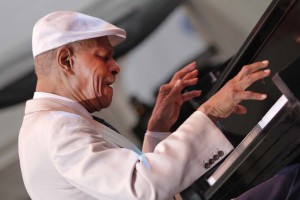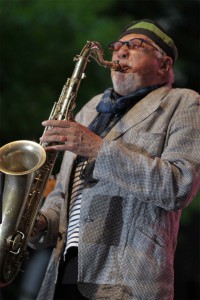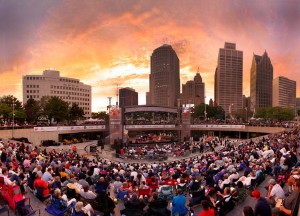What has long been known as the Motor City has done more than just put America on wheels. It’s also helped create much of the music Americans have listened to on their car radios.
The Motown sound emerged from a small, run-down studio filled with eager young talents like Marvin Gaye and Diana Ross, many of whom grew up in tough inner-city neighborhoods where opportunity meant getting a job on the assembly line, getting a gig in a band, or struggling for each meal. But long before Berry Gordy launched his record label, Detroit was already a major force on the national music scene. And the sounds of jazz and blues that filled the city’s clubs and dance halls were fueled by the same force, the auto industry.
The Labor Day weekend brings with it the annual Detroit Jazz Festival which, after three decades, has become the world’s largest free jazz gathering, and event that brings out some of the biggest names of that genre – more than a few with long ties to the Motor City, including the likes of bassist Ron Carter, violinist Regina Carter, and pianist Barry Harris.
While Detroit may be better known as a haven for soul, R&B, the Blues, and even rap music – the latter thanks to such modern-day stars as Eminem, its ties to jazz data back a century, point out authors Lars Bjorn and Jim Gallert, in their book, “Before Motown: A History of Jazz in Detroit.”
Exactly when jazz came to Detroit remains a matter of debate. By some accounts, it first arrived along with the first strains of Ragtime and Dixieland. Others date its introduction to the post-World War I years, possibly as late as the 1920s. It was a time when even the swells of American society were letting their hair down and swinging a bit, as the classic F. Scott Fitzgerald novel, the Great Gatsby, revealed.
Detroit had been a provincial backwater at the turn of the century, but with the opening of Henry Ford’s first automotive assembly plant, it quickly became the Silicon Valley of its day. The town burghers grew incredibly rich, while the plants were filled with immigrants – both from overseas and from the American South – looking for a better life.
The flood of money created strong demand for entertainment, and clubs, theaters, speakeasies and blind pigs were opening everywhere. Along with the society soirees, they became “training ground for wannabe jazz musicians,” according to an essay on the website of Detroit’s Graystone Jazz Museum. “(Their) bands entertained at clubs, community events, and parties, sparking new dance patterns.”
Detroit’s jazz scene was as varied as the range of models and brands that rolled off its assembly lines, the essay notes, “While new styles evolved, old guards often held onto the former society band and big styles, creating a rich tapestry of jazz subcultures in Detroit, offering diversity to audiences who visited from across America.”
Detroit was as beholden to Jim Crow segregation as the Deep South, though that began to change in the 1930s along the assembly lines – and in the jazz clubs of long-gone Paradise Valley where whites and blacks would come together to hear the latest performers.
It created opportunities for not just local acts, like the McKinney Cotton Pickers, but, after World War II, nationally known innovators. For some years, Detroit became something of a second home for legendary trumpeter Miles Davis.
As with much of the country, Detroit’s jazz scene began to fade in the 1960s. Old clubs closed, others struggled to survive, especially after the city’s devastating riots. And when the first Detroit jazz festival was held in 1980, it seemed like something of a quixotic fantasy. Downtown Detroit back then was a virtual ghost town, especially on holiday weekends, but the first year saw crowds filling the then-new Hart Plaza.
The festival has had its good years, and some that threatened to be the event’s last. Auto industry money often had to be tapped to keep the Jazz Fest going, early on Ford Motor Co. kicking in cash, with Chrysler helping out for several years, through 2013. More recently, the new jazz label Mack Avenue Records has been the chief financial survivor. Ironically, despite taking place in the shadows of General Motors’ Renaissance Center headquarters, the maker is the only one of the Big Three not to have lent major support.
The Detroit Jazz Fest will run through the entire Labor Day weekend, bringing in such big national names as saxophonist Joshua Redman, composer and pianist Ramsey Lewis, and the multi-talented Wayne Shorter. But it will also highlight local artists, such as Marcus Belgrave, a reminder that Detroit remains as much a jazz town as it is Motown or Motor City.



